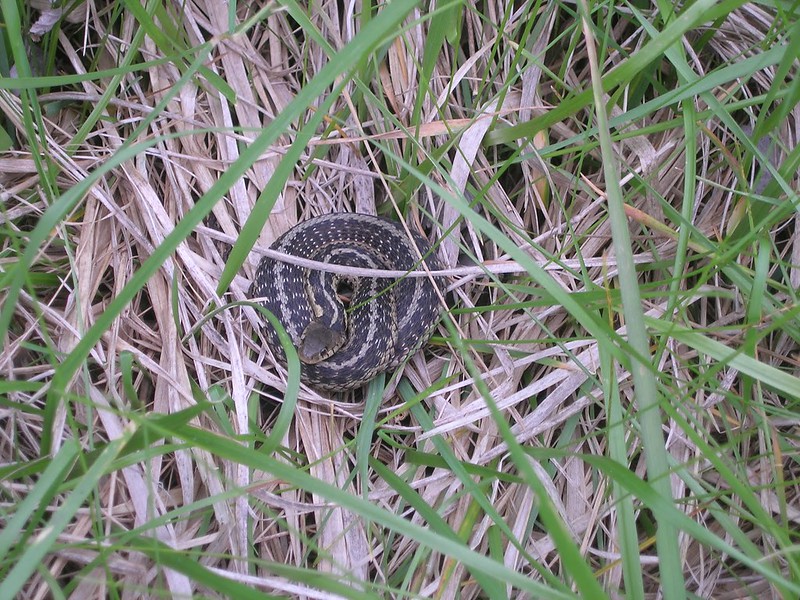During one of our return trips from Starved Rock State Park, I’d noticed something new to me — Midewin National Tallgrass Prairie. We couldn’t find a convenient entrance, so we made a mental note to check it out on another day. This was the day.
For me, May 1 began with breakfast at Bonjour, while J had the less pleasant task of going to a dentist’s appointment. We met at the Homewood train station, made the obligatory trip to Caribou, and stopped at Walgreens (I had a premonition that wet wipes would come in handy). At last we set off down I-80.
I wasn’t sure the welcome center would be open as I didn’t know how they define “summer,” but it was, and was worth the stop. Graphics showed the history of the area, how the prairie was formed, and how it shrank to less than .1 percent of its former extent. The graphics alluded to the Black Hawk War, for which, we had learned the previous week, Abraham Lincoln had signed up, and the forced removal of the Potawatomi from Illinois. J picked up some goodies, and I bought an anthology of Chicago nature essays. We collected a number of guides (to birds, spiders, etc.), then took off for the trails.
On the way to the first trail head, we pulled up next to a sign with a list of emergency radio stations. Immediately I thought of tornadoes — it’s the perfect area for them, flat and open. Much later, I realized we were in the vicinity of the Braidwood and Dresden power plants. If there’s an alarm, it’s not a tornado but something potentially more far reaching and deadly.
The first trail was an interim one along a stream and wetland. At first I had gone the wrong way and missed the trail head, but at least we saw this fellow (fortunately, I spotted him before I put my foot down). J took this photo, but I must have leaned in too close too suddenly because abruptly he flew into action and whipped off, disappearing into the layers of grasses. Shame on me — I should know better than to frighten off the wildlife, especially snakes.
We followed the temporary mowed trail until our shoes were soaked, at which point I finally looked at a map and realized the trail didn’t loop. We turned back at the limit of my endurance, and his, too, because he lagged behind me as though he’d run out of steam.
On the way out along the stream we’d seen and heard three frogs hopping away from us into the dense vegetation. We’d also heard what seemed to be the constant pop of guns in the distance, and I wondered if we should have picked up the mesh hunter orange vests at the welcome center. Later we learned that it’s turkey season, with hunting allowed in the morning. We didn’t see any turkeys, and, judging from the near-constant pop-pop-pop for a while, there seemed to be 50 to 100 shots for every turkey that could possibly be in the area. Or there’s a shooting club nearby.
The return trip was quieter, with only a few birds, mostly grackles and red-winged blackbirds, breaking the peace. Mosquito season must have begun already because I caught one taking a chunk out of my hand.
For a while we drove down the road through the prairie land, discovering, among other things, a Dresden cooling lake (my first clue as to our proximity to the power plants) and the Des Plaines State Fish and Wildlife Area. We stopped at the lake and at a few points along the mighty Kankakee River, which from certain viewpoints could look almost unsettled — until boats and jet skis roar past. I imagine some of Chicago’s affluent citizens have vacation homes in the area. I might if I could, although I also think that if I could afford to live anywhere, it would not be Chicago!
By now, it was getting late in the day, so we headed toward the Iron Bridge trail head. These trails wind through areas that could someday resemble a prairie, and a sign informs you of the efforts to restore and overseed the land formerly used for agriculture. Another sign warns you of turkey hunting season and times, and suggests that it would help to wear hunter orange at all times. Fortunately for us (and the turkeys), officially the shooting was over for the day.
While drier, the trail wasn’t as interesting to me and probably won’t be until it starts to look like a tallgrass prairie, which could take many years. Wildflowers added color to some of the fields, but the area seemed to be relatively featureless — until we came upon bunkers with grass growing on them. I don’t know exactly what they are, or indeed if I want to know. I’d guess they’re holdovers from the Joliet Army Ammunition Plant/Arsenal. I wonder if the public is allowed inside them and what can be found there.
Finally, overcome by hunger and other human urges, not to mention muscle fatigue, I turned us around so we could to Hayden’s Crossing in Wilmington, a small Route 66 town whose downtown seems to be dominated by a biker bar blaring music. Later in Utica, Illinois (population 1,000), I noticed a prominent biker culture. I suppose I’d forgotten this aspect of small-town America.
Hayden’s Crossing is a popular spot, with a Saturday evening 30-minute wait for a table under its rustic wood beams. As we delved into very good comfort food, we watched the babies at neighboring tables coo, smile, and slap their way to the servers’ hearts.
Ah, I couldn’t help thinking — there goes the next generation of bikers.

